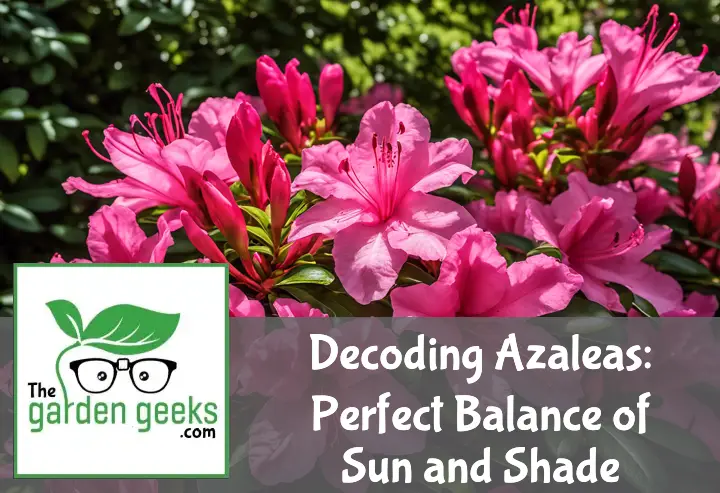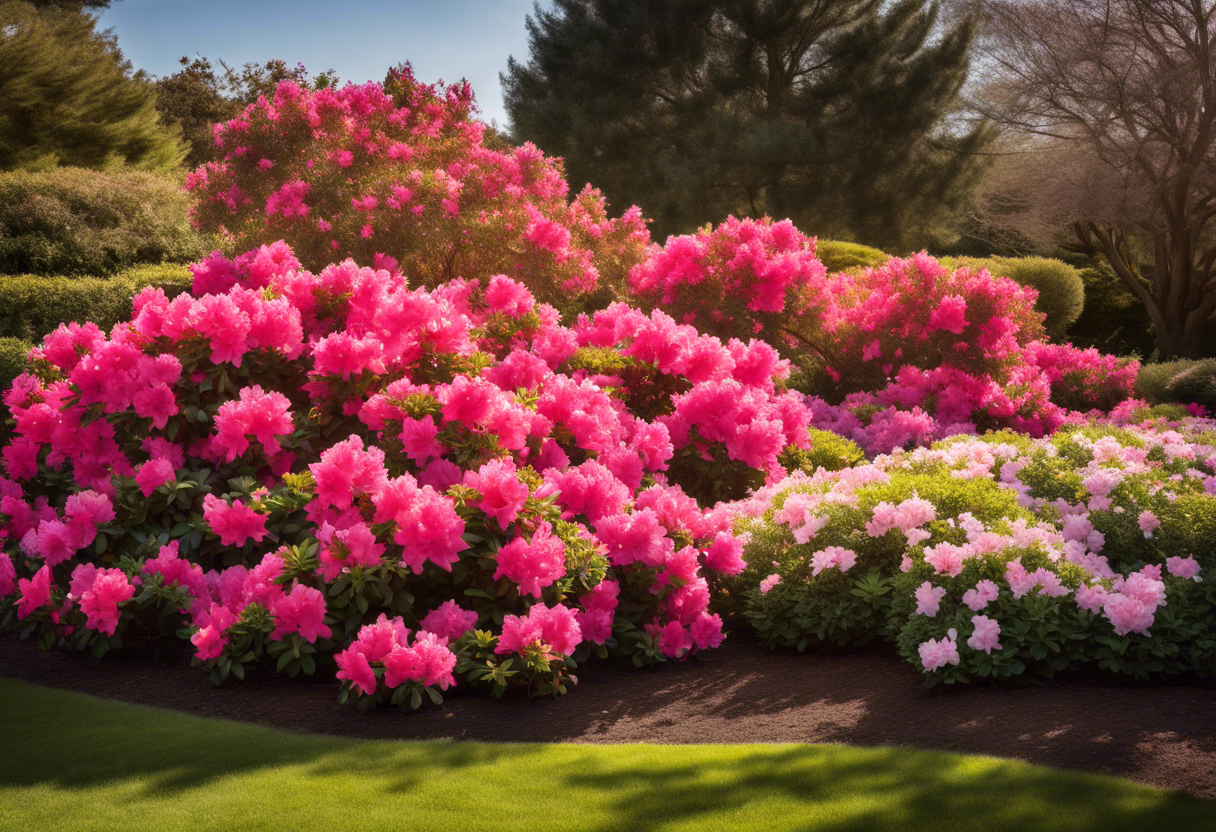Ever had a moment of sheer awe, gazing at the vibrant bloom of an Azalea bush? It’s like Mother Nature decided to throw a color party and forgot to hold back on the confetti! But behind that riotous display of colors, there’s a delicate science at play. Decoding Azaleas isn’t just about understanding their sun and shade needs, but unraveling a beautiful mystery.
Azaleas are not your run-of-the-mill divas. They demand attention, but in the right proportions. Sunlight? Yes, please! Shade? Absolutely necessary! Striking that perfect balance can be tricky, but stick around as we delve into this fascinating world. Keep reading about ‘Decoding Azaleas: Perfect Balance of Sun and Shade’.
Key Takeaways
- Azaleas thrive in a balance of sun and shade, with ideal exposure being morning sun and afternoon shade.
- Too much sun can cause leaf scorch, while too much shade can lead to sparse flowering and leggy growth.
- Azaleas prefer slightly acidic soil with good drainage.
- Regular watering is essential, but overwatering can lead to root rot.
- Pruning should be done after blooming to avoid cutting off next year’s flowers.
What are Azaleas?
Well, let’s get into the nitty-gritty of Decoding Azaleas. These beauties, known as azalea plants, belong to the Rhododendron genus. They’re flowering shrubs that can really jazz up your garden. When it comes to azalea care, they need a perfect balance of sun and shade.
Origin and Classification of Azaleas
Azaleas hail from the botanical classification of azaleas under the Rhododendron genus. They’re native to several continents including Asia, Europe, and North America. The origin of azaleas is quite fascinating with a rich history dating back hundreds of years.
These flowering shrubs are divided into two main groups: the evergreen azalea species and deciduous azalea species. Each group has its own unique characteristics and care requirements.
Different Varieties of Azaleas
There’s a smorgasbord of popular azalea varieties out there for you green thumbs! Evergreen azaleas are a crowd favorite due to their year-round foliage and vibrant flowers.
On the other hand, deciduous azaleas may lose their leaves in winter but come springtime, they burst into a riot of colors that’s worth the wait! Each variety has unique features of azaleas that make them stand out in any garden setting.
Why is Sunlight Important for Azaleas?
Sunlight, my friends, is the lifeblood of our beloved azaleas. It’s like their morning coffee, kick-starting their day and fueling their growth. The importance of sunlight for Azaleas growth cannot be overstated.
Photosynthesis in Azaleas
You see, azaleas are quite the sun-worshippers. They soak up those rays and use them to perform a little magic trick called photosynthesis. This photosynthesis process is how they turn sunlight into food.
The sun’s rays hit the leaves, and something amazing happens. The chlorophyll and sunlight interact, sparking a chemical reaction that produces glucose – or as I like to call it, plant candy! This glucose is what gives the azalea its energy to grow and bloom.
So next time you see an azalea basking in the sunshine, remember it’s not just sunbathing – it’s making lunch!
Optimal Sunlight Requirements for Azaleas
Now let’s talk about how much sun these green divas actually need. The ideal sunlight for azaleas isn’t a one-size-fits-all answer. It can depend on several factors.
Some azaleas prefer full sun while others enjoy partial shade. The type of azalea you have will determine its sunlight duration needs. But generally speaking, most varieties thrive with 4-6 hours of dappled sunlight each day.
Remember though, too much direct sunlight can scorch their leaves while too little may lead to fewer blooms. So finding that sweet spot of light exposure is crucial for your azalea’s health.
And there you have it folks! A quick dive into the world of Decoding Azaleas, where we’ve learned that balance between sun and shade is key to keeping your azaleas happy and healthy.
Why is Shade Important for Azaleas?
When it comes to Decoding Azaleas, one of the key elements is understanding the importance of shade. It’s not just about aesthetics, folks! Shade plays a crucial role in azalea care, particularly in preventing sunburn and meeting the plant’s sunlight needs.
The Role of Shade in Preventing Sunburn
Now, you might be thinking, “Sunburn? In plants?” Yes indeed! Just like us humans, azaleas can get sunburned too. Excessive sunlight can cause damage to their delicate leaves. That’s where shade steps in to save the day.
Shade acts as a sort of sunscreen for azaleas, protecting them from harmful effects of too much sun exposure. It’s like giving your azaleas a little parasol to keep them cool and happy. And trust me, a happy azalea is a sight to behold!
Optimal Shade Requirements for Azaleas
So how much shade do these beauties need? Well, it’s all about balance. Too little light and they won’t bloom; too much and they risk getting sunburned.
The optimal shading for azaleas varies depending on factors such as climate and variety. But generally speaking, they thrive best with morning sun and afternoon shade.
Remember folks, Decoding Azaleas isn’t rocket science! With proper care and attention to their light needs, you’ll have healthy azaleas that are the envy of your neighborhood!
How to Achieve the Perfect Balance of Sun and Shade for Azaleas?
When it comes to Decoding Azaleas, achieving the perfect balance between sun and shade is key. It’s like a dance, you see. Too much sunlight can scorch their delicate leaves, while too little can stunt their growth. So, let’s dive into how you can strike this balance in your garden.
Assessing Your Garden’s Light Conditions
First things first, you gotta know what you’re working with. Start by assessing your garden’s light conditions. This means figuring out how much sun your garden gets throughout the day.
Is it bathed in sunlight from dawn till dusk? Or does it enjoy a healthy mix of sun and shade? These are crucial questions when considering azalea care.
Once you’ve got a handle on your garden’s light situation, compare it with the sunlight requirements for azaleas. These shade-loving plants prefer dappled sunlight rather than direct exposure. So if your garden is more Sahara Desert than English woodland, you might need to rethink your azalea planting guide.
Positioning Your Azalea Plant Correctly
Now that we’ve sorted out the light situation, let’s talk about positioning. Where you plant your azalea can make a world of difference in its health and happiness.
Look for an area in your garden that gets morning sun but is shaded during the hottest part of the day. This is often considered the optimal location for azaleas.
If you’re potting your azalea, remember that pots can be moved! Don’t be afraid to play around with different locations until you find one that meets these conditions.
Using Artificial Shade Solutions
But what if your garden is more sun-drenched patio than shady oasis? Well my friend, it might be time to consider artificial shading solutions.
These can range from shade cloths to pergolas, and can provide your azalea with the protection it needs from harsh sunlight. Just remember, while you’re protecting your plant from direct sun, it still needs some indirect light to thrive.
So there you have it! With a bit of garden light assessment, some strategic positioning, and perhaps a dash of artificial shade, you’ll be well on your way to Decoding Azaleas.
Common Mistakes in Balancing Sun and Shade for Azaleas
When it comes to Decoding Azaleas, one of the most common azalea care mistakes is not striking the right balance between sun and shade. Too much or too little of either can lead to a whole host of problems.
Overexposure to Sunlight
Azaleas are like Goldilocks, they don’t want too much sun, nor too little. They want it just right! Overexposing your azaleas to sunlight can result in what’s known as azalea sunburn. Yes, plants can get sunburned too!
The signs of overexposure in azaleas are pretty clear. If your plant’s leaves start turning yellow or brown, or if they appear scorched, you might be dealing with a case of sunburn.
This isn’t just an aesthetic issue either. The effects of too much sun on azaleas can be detrimental to their health and survival. It’s like forcing someone who hates heat to live in the desert!
But don’t worry, preventing sun damage in azaleas isn’t rocket science. It’s all about finding that sweet spot between sunlight exposure for azaleas and their shade requirements.
Excessive Shading
On the flip side, excessive shading is another common mistake when balancing sun and shade for azaleas. While these plants do enjoy some shade, there is such a thing as too much of a good thing!
Excessive shading can stunt your azalea’s growth and even prevent them from flowering properly. Imagine working hard all year round only to find out you won’t get any vacation time! That’s how your azalea feels when it doesn’t get enough light.
The signs of insufficient light in azaleas include leggy growth and fewer flowers. But again, this issue is preventable. By ensuring your azaleas get just the right amount of light, you can avoid improper azalea care and keep your plants happy and healthy!
To Wrap Up
Like a perfect salsa dance, Azaleas require the right balance of sun and shade to bloom their best. We’ve unlocked some secrets in Decoding Azaleas, haven’t we?
Now it’s your turn to apply these insights and watch your garden transform into an Azalea paradise. Happy gardening!





